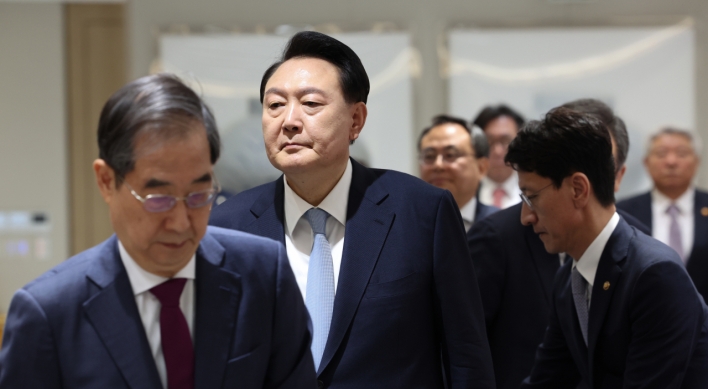[William Pesek] Indian inflation above 9% shows bankers are no longer gods
By 류근하Published : March 2, 2011 - 17:55
Duvvuri Subbarao knows a thing or two about inflation. India’s central-bank head defeated price gains exceeding 10 percent twice in the past two years alone.
Now, Subbarao is back at battle stations as a chorus of traders say he’s behind the curve. It’s hard to argue with the wisdom of markets with Indian inflation back above 9 percent, the highest among Asia’s 10-biggest economies.
Yet the Reserve Bank of India is the vanguard of a worrisome phenomenon in the world’s most vibrant economic region. Central banks are in over their heads and need help from politicians. Higher interest rates alone won’t cut it.
Subbarao personifies the shifting economic sands. Prior to taking the monetary reins in September 2008, he was a top World Bank economist from 1999 to 2004. Back then, central bankers like then-Federal Reserve Chairman Alan Greenspan were treated like gods for their supposed omnipotence to tame inflation.
Several asset bubbles and one global crisis later, we know better. The ongoing surges in prices of commodities such as food are fanning Asian inflation and they require bold action. Higher rates will only do so much. It’s time for politicians to do their part to reduce fiscal-stimulus excesses.
Just before joining India’s central bank, Subbarao said monetary policy is the “first line of defense” against price pressures. Now, he is being very vocal in urging the government to curtail fiscal policies that are working at cross purposes with interest rates.
And good luck with that. India’s government yesterday unveiled a budget proposal that kept the onus on the central bank to contain prices. That should be a concern for investors.
Events from Egypt to Tunisia and from Libya to Yemen show just how destabilizing rising food costs can be. For officials in New Delhi and those controlling budgets in India’s 28 states, the focus is on subsidies ― ways to shelter households living on the edge. That makes sense in a nation where 66 percent of the population lives on less than $2 a day.
In the week ended Feb. 5, food inflation was 11.1 percent. That marked the 10th consecutive week in which food cost-increases held above 10 percent. Such increases are beyond unsustainable.
Let’s remember, though, where the blame for all this lies. Elected officials dragged their feet for years on boosting agricultural production to curtail prices. At the very least, India must allocate ample funds for more efficient warehousing and distribution of farm products. More money must be invested in improved irrigation techniques and infrastructure.
Among the handful of people who saw this coming was Rob Subbaraman, chief economist for Asia excluding Japan at Nomura Holdings Inc. in Hong Kong. Nomura’s September report titled “The Coming Surge in Food Prices” is a sobering road map for where the global economy is heading. It predicts, and very convincingly, a multiyear jump in food costs.
The problem is many Asian governments are thinking this jump in commodity prices is cyclical, not secular. Demographics is one reason to expect prices to keep rising. Dithering among government officials is another. Governments aren’t doing enough to make sure that the supply side of the equation comes at least close to meeting the demand side.
That’s not to give central banks a pass. Monetary policy makers left the punchbowl out for too long in recent years. From Seoul to Jakarta, rates need to go higher to reduce price gains risks. Asia risks falling behind the curve on inflation.
Yet there are two reasons to at least partially give central bankers the benefit of the doubt. One is hot money. Fed Chairman Ben Bernanke is flooding the globe with liquidity. So are central banks in Japan and Europe. Lots of that money is heading to Asia, and higher rates may only attract more of it as investors seek more generous returns.
The other reason is the risk of shoulder checking economies. Central banks in India, Indonesia and the Philippines must balance inflation risks with poverty. They worry about ushering in a period of stagflation, that dreaded combination of weakening growth and steepening price increases.
It’s time for politicians to earn their paychecks. During a credit crisis, fiscal policy is more effective in steering economic activity than monetary policy anyway.
The 1990s and early-to-mid 2000s were a time of policy drift in which governments deferred economic fine-tuning to central banks. It was left to them to keep growth up and consumer prices down. That willful neglect has run its course. The job can no longer be fobbed off on central bankers alone.
Subsidies are a bandage that treats the symptoms of rising inflation, not the causes. That will become painfully apparent very quickly if uprisings in Libya and elsewhere lead to a global oil shock. That would be the last thing the developing world needs amid a food-price surge.
India’s 8.9 percent growth rate is impressive. Yet inflation explains why investors aren’t more excited about it. Winning back their esteem will take more than Subbarao’s interest rate hikes. The government needs to get busy, too.
By William Pesek
William Pesek is a Bloomberg News columnist. The opinions expressed are his own. ― Ed.
(Bloomberg)
Now, Subbarao is back at battle stations as a chorus of traders say he’s behind the curve. It’s hard to argue with the wisdom of markets with Indian inflation back above 9 percent, the highest among Asia’s 10-biggest economies.
Yet the Reserve Bank of India is the vanguard of a worrisome phenomenon in the world’s most vibrant economic region. Central banks are in over their heads and need help from politicians. Higher interest rates alone won’t cut it.
Subbarao personifies the shifting economic sands. Prior to taking the monetary reins in September 2008, he was a top World Bank economist from 1999 to 2004. Back then, central bankers like then-Federal Reserve Chairman Alan Greenspan were treated like gods for their supposed omnipotence to tame inflation.
Several asset bubbles and one global crisis later, we know better. The ongoing surges in prices of commodities such as food are fanning Asian inflation and they require bold action. Higher rates will only do so much. It’s time for politicians to do their part to reduce fiscal-stimulus excesses.
Just before joining India’s central bank, Subbarao said monetary policy is the “first line of defense” against price pressures. Now, he is being very vocal in urging the government to curtail fiscal policies that are working at cross purposes with interest rates.
And good luck with that. India’s government yesterday unveiled a budget proposal that kept the onus on the central bank to contain prices. That should be a concern for investors.
Events from Egypt to Tunisia and from Libya to Yemen show just how destabilizing rising food costs can be. For officials in New Delhi and those controlling budgets in India’s 28 states, the focus is on subsidies ― ways to shelter households living on the edge. That makes sense in a nation where 66 percent of the population lives on less than $2 a day.
In the week ended Feb. 5, food inflation was 11.1 percent. That marked the 10th consecutive week in which food cost-increases held above 10 percent. Such increases are beyond unsustainable.
Let’s remember, though, where the blame for all this lies. Elected officials dragged their feet for years on boosting agricultural production to curtail prices. At the very least, India must allocate ample funds for more efficient warehousing and distribution of farm products. More money must be invested in improved irrigation techniques and infrastructure.
Among the handful of people who saw this coming was Rob Subbaraman, chief economist for Asia excluding Japan at Nomura Holdings Inc. in Hong Kong. Nomura’s September report titled “The Coming Surge in Food Prices” is a sobering road map for where the global economy is heading. It predicts, and very convincingly, a multiyear jump in food costs.
The problem is many Asian governments are thinking this jump in commodity prices is cyclical, not secular. Demographics is one reason to expect prices to keep rising. Dithering among government officials is another. Governments aren’t doing enough to make sure that the supply side of the equation comes at least close to meeting the demand side.
That’s not to give central banks a pass. Monetary policy makers left the punchbowl out for too long in recent years. From Seoul to Jakarta, rates need to go higher to reduce price gains risks. Asia risks falling behind the curve on inflation.
Yet there are two reasons to at least partially give central bankers the benefit of the doubt. One is hot money. Fed Chairman Ben Bernanke is flooding the globe with liquidity. So are central banks in Japan and Europe. Lots of that money is heading to Asia, and higher rates may only attract more of it as investors seek more generous returns.
The other reason is the risk of shoulder checking economies. Central banks in India, Indonesia and the Philippines must balance inflation risks with poverty. They worry about ushering in a period of stagflation, that dreaded combination of weakening growth and steepening price increases.
It’s time for politicians to earn their paychecks. During a credit crisis, fiscal policy is more effective in steering economic activity than monetary policy anyway.
The 1990s and early-to-mid 2000s were a time of policy drift in which governments deferred economic fine-tuning to central banks. It was left to them to keep growth up and consumer prices down. That willful neglect has run its course. The job can no longer be fobbed off on central bankers alone.
Subsidies are a bandage that treats the symptoms of rising inflation, not the causes. That will become painfully apparent very quickly if uprisings in Libya and elsewhere lead to a global oil shock. That would be the last thing the developing world needs amid a food-price surge.
India’s 8.9 percent growth rate is impressive. Yet inflation explains why investors aren’t more excited about it. Winning back their esteem will take more than Subbarao’s interest rate hikes. The government needs to get busy, too.
By William Pesek
William Pesek is a Bloomberg News columnist. The opinions expressed are his own. ― Ed.
(Bloomberg)







![[KH Explains] How should Korea adjust its trade defenses against Chinese EVs?](http://res.heraldm.com/phpwas/restmb_idxmake.php?idx=644&simg=/content/image/2024/04/15/20240415050562_0.jpg&u=20240415144419)










